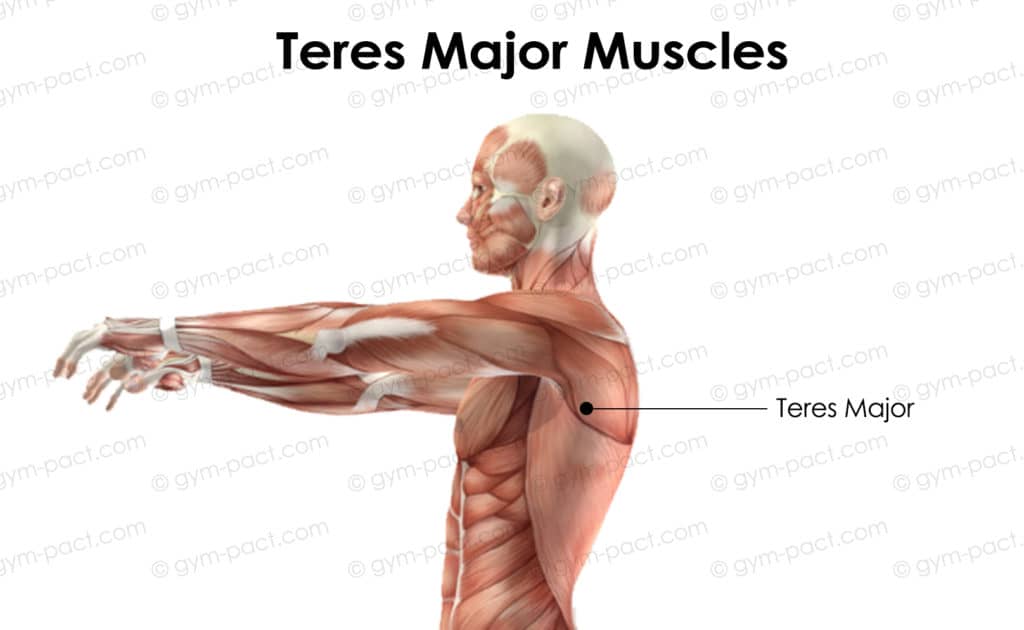The Teres Major is a muscle that is situated just above your latissimus dorsi (lats), it is informally known as the “lats’ little helper”. Its main role is to help improve stability in the shoulder, rotation of the upper arm, and it helps the lats to pull your arms downwards and backward (as you would when performing a lat pulldown). They are a crucial part of shoulder adduction and external rotation.
The teres major muscle is often confused with the rotator cuff muscle and teres minor, which is understandable, they are both minor muscles situated around your shoulder blades and shoulder joint. But it would be better to think of the teres major as a mini-lat muscle.

Teres major and teres minor injuries are incredibly rare unless you are a professional baseball pitcher (shoulder impingement syndrome), so you don’t really need to train the teres major as a form of pre-hab. They play very little part in shoulder health, and if you have a shoulder injury it is unlikely to be due to aggravating your teres major.
There aren’t any particular benefits to isolating the teres major either. Most major back exercises will target the teres major, and provided you perform them with good form, your teres major should receive enough attention during a regular back session.
Here are ten major exercises that will work the teres major.
1. Face Pulls
Why it’s a Great Alternative
Face pulls are perhaps the most underrated corrective exercise out there. They are incredibly effective as a warmup exercise for tight muscles or as part of a back or shoulder workout. Face pulls are great for shoulder stability.
Equipment Needed
For this exercise, you will need a rope attachment cable station with a rope pulley.
How to Perform
- Stand facing the cable station with your rope attached and the cable set to head height (or higher).
- Grab the handles in each hand (check out Nick Tumminello’s video for the best way to hold each handle) and take a large step backward.
- You can position your legs so that one is in front of the other, or you can have both feet next to each other, whichever is more comfortable.
- Pull the rope handle backward towards your forehead, keep your elbows high, and bring the handles back as far as you can go without leaning backward.
- Pause, and then return the handles to the starting position.
2. Inverted Row
Why it’s a great alternative
Pull-ups and chin-ups work the teres major nicely, but the inverted row is not only more accessible to the general public (it is easier), it is also more effective at targeting the teres major.
Equipment needed
For this fantastic exercise, you are going to want a Smith machine, as it will provide a stable pull-up bar that can be set to hip height. Some people place the bar at shoulder height, but this really affects the angle. Don’t worry, it may sound like a complicated exercise but it really isn’t.
How to Perform
In the video for this exercise, Nick Tumminello recommends using a wider grip as this will target the middle back muscles. But if you really want to target the teres major muscles you may want a narrower grip or even an underhand grip. It’s up to you, all versions will target the teres major.
- Lie underneath the bar so that your chest is directly below it.
- Grab hold using your preferred grip and width, then straighten your legs and hang under the bar with your heels touching the ground. This is your starting position.
- Take a deep breath and then pull yourself up until your chest is almost touching the bar. Nick Tumminello’s video recommends placing a pad over the barbell and rising until you touch the pad, but this is unnecessary.
- Pause at the top, and then slowly lower yourself back down to the starting position.
- You can add a resistance band to this exercise if you want. Just make sure that your resistance band is thick enough to support you.
3. Seated Cable Row (Close-Grip)
Why it’s a Great Alternative
The wider grip version of the seated cable row may be a better exercise for targeting the teres major muscle. But the close-grip version is still effective and is in many other ways a better exercise overall so that’s why it’s included here. It also allows you to use a heavier weight and makes it easier to stay in a locked position throughout.
Equipment Needed
Cable Row Machine
How to Perform
- Set yourself up so that your feet about shoulder-width apart on the footplate, knees bent, and your upper back is leaning back at a very slight angle with your chest pushed out. This is the ideal position.
- Grab the handles in both hands, take a deep breath, and then pull the handles towards your upper abdominals.
- Pause, and then return the handles to the starting position.
4. Underhand Barbell Bent Over Row
Why it’s a Great Alternative
This is one of the best back and bicep barbell exercises of all time and is also a great exercise for the teres major. It’s a serious lat builder!
Equipment Needed
For this exercise, you will need a barbell, and you will also need to be able to bend over with a straight back while performing it. If you don’t yet have the mobility to achieve this, perform a cable row or low row instead.
How to Perform
- Grab a barbell in an underhand grip and hold it at waist height.
- Bend your knees slightly, then lean forward until your torso is at around 45 degrees.
- Push your chest out and pull your shoulders back. This is your starting position.
- Take a deep breath and then pull the barbell up into your upper abdominals.
- Pause, and then slowly lower the barbell to the starting position.
There is also a dumbbell row exercise that is similar to this, which is another excellent exercise for beginners.
5. Single-Arm Lat Pulldown
Equipment Needed
For this exercise, you will need a lat pulldown that has single arm capabilities. If you don’t have one, then just perform an underhand grip two-handed lat pulldown instead.
How to Perform
- Sit at the lat pulldown so that your knees are cozy against the knee pads.
- Shuffle yourself forwards, then push your chest out and lean back very slightly.
- Grab a handle in your weak hand, then pull it down until the handle is in line with the side of your shoulder.
- Pause, and then slowly return it to the starting position.
In the video, Chris Martinez demonstrates a neutral grip, but you could also perform this with a regular grip if the lat pulldown has two separate handles rather than just one in the middle.
6. Single-Arm T-Bar Row
Why it’s a Great Alternative
The T-Bar Row is not always available in many gyms. If it isn’t then perform a regular single-arm dumbbell row instead. However, if you can do this, you will find it a beneficial exercise for the lats and teres major. As Kris Gethin says in the video, the single-arm T-bar row tends to work the wider back muscles better than the dumbbell, and the teres major is a wide back muscle.
Equipment Needed
T bar row machine
How to Perform
- Place a small plate on the T-bar row. Don’t use the large plates as they will be too cumbersome and will keep hitting your chest as you row.
- Grab the barbell just before the weighted plates and stand to one side of it.
- Bend over with a slight bend in your knees, and push that chest out for a flat back.
- Lift the barbell off the floor like you would a suitcase, this is your starting position.
- Row the barbell up into your chest, pause, and then lower to the starting position. Finish your allotted reps and then switch arms.
7. Straight Arm Pulldown
Why it’s a Great Alternative
This is a great cable exercise to work your lats and your teres major muscle. You may also feel it in your triceps.
Equipment needed
For this exercise, you will need a straight bar attached to a cable machine, with the pulley set as high as possible. This can also be performed on some lat pulldown machines, but many don’t allow the full range of motion, so test it out beforehand.
How to perform
- Place both hands on the straight bar attachment and then take a step back, bring your arms down so that they are parallel with the floor then lean forward slightly. While it is called a straight arm pulldown, you are actually allowed a slight bend in your arms. Just don’t overdo it.
- Keeping your arms stiff, lower the bar down and towards your body until the bar hits your waist/thighs. Ideally, you want your lats to initiate this movement.
- Pause, and then slowly return the bar to parallel.
Do this exercise well and it will also feel like an advanced ab exercise as it really hits your core.
8. Dumbbell Rear Deltoid Fly
This dumbbell exercise can be performed in the bent-over position required for the bent-over row, or it can be performed while lying chest down on an incline exercise bench. The standing version is slightly better, but the bench version is more accessible as it can be done even if you have poor mobility. We’ll discuss the bench version here.
Set the bench to a 45-degree angle, and then straddle the exercise bench so that your upper chest is flush with the headrest. Hold a light dumbbell in each hand, and bend your arms ever so slightly. Your hands should be underneath the incline bench so that it looks like you are clapping your hands.
Spread your slightly bent arms out like a bird flying, pausing when the back of your shoulders starts to burn. Pause, and then return your hands to their starting position, as if you have just performed a slow-motion clap.
One thing to watch out for is your chest rising off the bench. If it does this a tiny bit, then no big deal. But if your chest is fully coming off the bench with each rep, you are either using too much weight or trying to bring your arms back further than your shoulders and upper back are capable of. Be patient and over time your range of motion will improve.
9. Single-Arm Low Row Machine
Low row machine exercises are very similar to cable row machine exercises, except that they have a chest pad and the angle that the resistance starts is often lower. You could target the teres major with a two-handed version, but the single-arm low row is a really good exercise for the teres major.
Place your chest tight to the pad, place your feet in the footplates (if the machine has them) or flat on the floor. Then push your chest out, grab a handle in one hand, and pull it towards your chest. Pause when it reaches your chest, and then slowly return the handle to the starting position. Finish the requisite reps and then swap hands.
10. Dumbbell Pullover
The final exercise on this list is the dumbbell pullover. A dumbbell exercise that is traditionally thought of as a favorite chest exercise rather than a teres major one. However, the teres major is required for stability of the shoulders and the pulling movement as the dumbbell travels past your head.
Grab a flat exercise bench and lie on it so that you make a T shape. Your shoulders and upper back should be lying on the bench with your feet flat on the floor. Hold a dumbbell on its side with your hands in a diamond. The dumbbell should start directly over your chest. Take a deep breath and then slowly bring the dumbbell over your head so that you finish off with your arms straight out above your head, and the dumbbell hanging parallel to the ground.
Pause, and then engage your lats to pull the dumbbell back over your head and back to the starting position. This exercise is hard to envision using just the written word, so please check out the YouTube video for a better explanation.
Conclusion
As you can see, the teres major targeting exercises mentioned above are all fairly standard upper back exercises that you are probably performing anyway. That is absolutely fine, the teres major muscle does not require any special attention. It works very well with the latissimus dorsi, and any exercise that targets your lats will provide just enough work for your teres major to also grow.
Frequently Asked Questions
How do you strengthen your teres major?
By performing a normal upper back workout, lots of lat exercises performed with perfect form should do more than enough to develop your teres major.
How do I make my teres major bigger?
Perform exercises that focus on the lats and the wider muscles of your upper back. Follow a hypertrophy rep range (8-12) and eat enough protein for growth.
Can you tear your teres major?
While it is possible, it is incredibly rare. Unless you are a professional baseball pitcher. It is more likely that you have torn your lat. Get it checked out by a personal trainer or physiotherapist rather than just assuming the worst.



